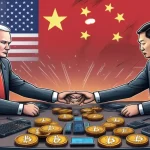US Tariff Cut on Swiss Goods to 15%: Trade Win with Crypto Valley Implications

US Slashes Tariffs on Swiss Goods to 15%: Trade Breakthrough with Crypto Ripples
A major trade barrier is coming down as the United States prepares to reduce tariffs on Swiss imports from a brutal 39% to a more bearable 15% by early December. Swiss Minister of Economic Affairs Guy Parmelin confirmed this shift, hinting at a thaw in strained US-Switzerland trade relations, but with plenty of fine print and potential pitfalls ahead. Beyond traditional economics, this could send waves through Switzerland’s blockchain hub—Crypto Valley—potentially fueling innovation in decentralized tech.
- Tariff Drop: US cuts tariffs on Swiss goods from 39% to 15% by early December.
- Swiss Pledge: Swiss firms commit to $200 billion in US investments by 2028.
- Roadblocks: Negotiations and parliamentary approvals still loom large.
The Tariff Cut: A Lifeline for Swiss Exporters
For Swiss exporters, this tariff reduction is nothing short of a rescue mission. Since August of last year, the US imposed a staggering 39% tariff on Swiss goods—the highest slapped on any European nation. This crushed key industries like machinery, luxury watches, chemicals, and pharmaceuticals, which are the backbone of Switzerland’s export economy. Swiss National Bank Chairman Martin Schlegel noted that 4% of the country’s exports bore the direct brunt of this policy, with demand tanking and supply chains grinding to a halt in the US market. Smaller firms, already on thin margins, were hit hardest, often unable to absorb the cost or pass it on to American buyers.
Parmelin broke the news of the rollback in interviews with Swiss broadcaster SRF and the newspaper Aargauer Zeitung, detailing a preliminary agreement signed on November 14, as reported in a recent update on US tariff reductions. This deal includes a liability provision—basically a legal safeguard ensuring both sides stick to their promises. Once approved, the new 15% rate will take 10 to 12 working days to kick in. More importantly, it aligns Swiss exporters with competitors from the European Union in the US market, offering a fighting chance to reclaim lost ground. For context, a watchmaker in Geneva or a chemical plant in Basel could see their products become far more price-competitive overnight, potentially reviving orders that dried up over the past year.
But don’t bet the farm just yet. Parmelin was candid about the grunt work ahead, emphasizing that this isn’t a done deal. Further negotiations are needed, and parliamentary approval in both nations could turn into a slog—or worse, a damn circus if US politicians start posturing over “foreign concessions.” As he put it:
“The next step is a real conversation about implementation, so that the decrease is fully enacted and not just on paper.”
History backs his caution. US trade policy has been a wild ride lately, with protectionist swings catching allies off guard. The 39% tariff itself was a gut punch, born from broader tensions with European economies. If past spats—like disputes over steel tariffs with the EU—are any guide, this deal could still hit a wall. For Swiss exporters, the stakes are high, and the clock is ticking.
Switzerland’s $200 Billion Gamble: Strategic or Reckless?
Switzerland isn’t just banking on goodwill to secure this tariff relief. As part of the agreement, Swiss companies have pledged a jaw-dropping $200 billion in investments into the US by 2028. This cash injection spans sectors like chemicals, machinery, and high-tech—areas where Swiss expertise shines globally. Think precision engineering firms or cutting-edge R&D labs setting up shop stateside. It’s a clear quid pro quo: tariff cuts in exchange for economic boosts to American jobs and infrastructure. Parmelin framed this as a calculated move, rooted in hard-nosed diplomacy, stating:
“The government had exercised realpolitik… prudently and strategically to safeguard the nation’s long-term economic and political interests in an objective way that did not come at the price of its sovereignty.”
Translated, that means Switzerland is playing chess, not checkers, willing to make big bets without selling its soul. But let’s play devil’s advocate here. Is this $200 billion promise a masterstroke or a dangerous overreach? In a shaky global economy—think inflation spikes, geopolitical flare-ups, or even a US recession—this kind of commitment could stretch Swiss firms thin. If the US drags its feet on trade reforms or slaps on new restrictions, Switzerland might end up holding the bag, diverting funds from domestic priorities. Parmelin himself hinted at uneven readiness, noting:
“Switzerland is ready for the change… The U.S. will take a little longer to adjust.”
That’s a polite way of saying the US might fumble the ball while Switzerland waits, cash in hand. Navigating Capitol Hill on trade deals can be like mining Bitcoin with a spoon—possible, but painfully slow. The risk is real: if this deal sours, the financial strain could ripple back home, impacting everything from small businesses to innovation budgets.
Crypto Valley’s Hidden Stake: Blockchain in the Balance
Now, let’s zoom into why this matters for the crypto crowd. Switzerland isn’t just a land of chocolates and Alps; it’s home to Crypto Valley in Zug, a global hotspot for blockchain innovation. This tariff cut and the $200 billion investment pledge could indirectly fuel decentralized tech in ways that excite both Bitcoin maximalists and altcoin enthusiasts. For starters, stronger export sectors mean more revenue for Swiss firms, some of which could trickle into blockchain startups. Imagine a watchmaker, flush with new US orders thanks to the 15% tariff, funding a project to track product provenance on Ethereum or a similar protocol. Supply chain transparency is a perfect use case for immutable ledgers, and Swiss precision industries are tailor-made for it.
Moreover, the high-tech focus of the US investment could spark cross-border collaborations. A Swiss chemical giant partnering with a US firm might integrate blockchain for logistics or smart contracts for trade finance, accelerating real-world adoption of decentralized solutions. Switzerland’s already friendly crypto policies—think low taxes and regulatory clarity in Zug—position it to capitalize on this economic breathing room. Even the Swiss National Bank has explored central bank digital currencies (CBDCs), showing a willingness to bridge traditional finance with cutting-edge tech.
But there’s a flip side, and we’re not here to sugarcoat it. Economic uncertainty from a stalled trade deal or overextended investments could dampen risk appetite. Crypto and blockchain projects, often seen as speculative, might lose funding if Swiss companies prioritize safer bets to offset US commitments. And let’s be real: while Bitcoin’s borderless nature laughs in the face of tariffs, most blockchain applications still rely on stable traditional economies to thrive. If trade tensions reignite, the fallout could slow the very innovation we’re championing. It’s a tightrope, and Crypto Valley’s growth hangs in the balance.
The Bigger Picture: Trade Barriers vs. Decentralized Freedom
Stepping back, this US-Switzerland deal is a stark reminder of how centralized systems still call the shots in global finance. Bitcoin maximalists like us see trade policies as clunky relics—why should exporters bleed under arbitrary tariffs when a peer-to-peer currency could sidestep these games entirely? Imagine a world where Swiss watchmakers settle US orders in BTC, cutting out the middlemen and their bureaucratic nonsense. It’s not sci-fi; it’s the future we’re fighting for, rooted in freedom, privacy, and disruption of the status quo.
Yet, we can’t ignore reality. Altcoins and protocols like Ethereum are carving out niches that Bitcoin doesn’t fill, especially in trade-related smart contracts or tokenized assets. These tools could address friction points in deals like this, but they’re not there yet—not at scale. So, while we push for effective accelerationism in tearing down outdated structures, we’re stuck watching traditional mechanisms creep forward. This tariff cut, flawed and fragile as it is, shapes the capital flows and stability that crypto needs to flourish. Our mission holds firm: champion decentralization, but keep both eyes on these macro moves. They’re the undercurrents that can either lift or sink our financial revolution.
Key Takeaways and Burning Questions
- How does the US tariff cut to 15% impact Swiss exporters and blockchain innovation?
It’s a huge relief for industries like watches and machinery, boosting competitiveness in the US and potentially freeing up funds for Swiss blockchain startups in Crypto Valley. - What’s the weight of Switzerland’s $200 billion investment in the US?
It’s a strategic trade-off to lock in tariff relief, targeting high-tech sectors by 2028, which could drive blockchain collaborations but risks overextending Swiss resources. - Could this trade deal hit snags, and what’s the crypto fallout?
Damn right it could—political pushback or stalled negotiations might derail it, creating uncertainty that could choke investment in speculative fields like decentralized finance. - Why should Bitcoin and crypto fans track traditional trade policies?
These policies dictate economic stability and capital movement, directly influencing whether funds flow into or away from blockchain innovation and Swiss Crypto Valley growth. - Can decentralization solve trade friction better than deals like this?
In theory, yes—Bitcoin’s borderless nature and altcoin smart contracts could bypass tariffs, but scaling those solutions remains a hurdle while centralized systems dominate.
So, while this tariff slash marks a tentative win for freer trade, the jury’s out on its execution and broader impact. Bitcoin’s borderless promise keeps us grounded in the long game: the future of finance won’t wait for bureaucrats to get their act together. Stick with us as we track how these old-school maneuvers intersect with the unstoppable rise of decentralized tech.



